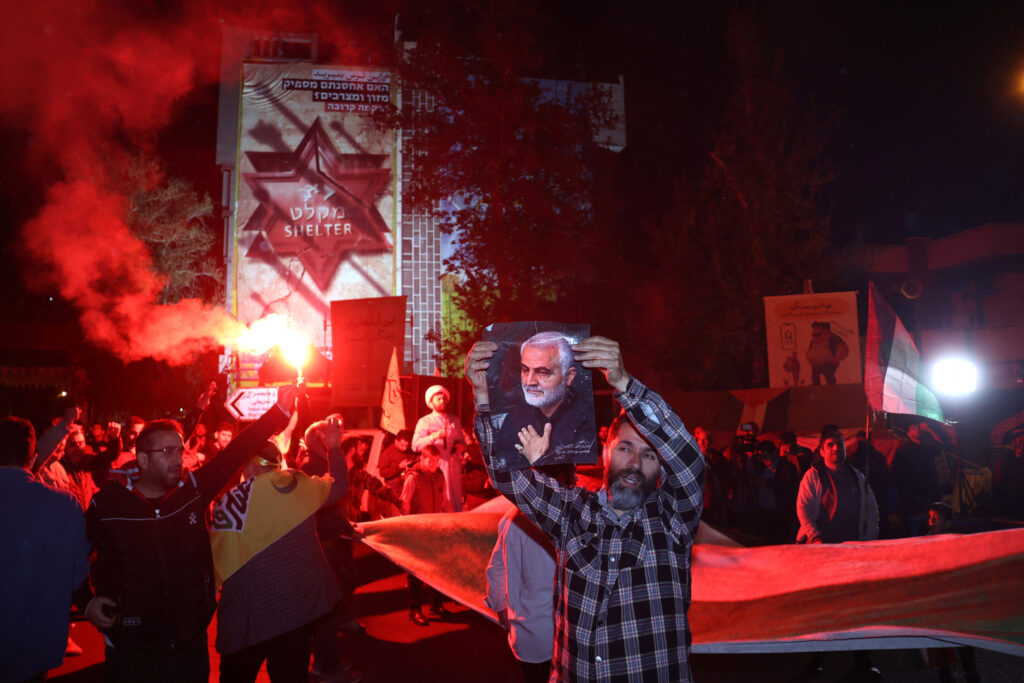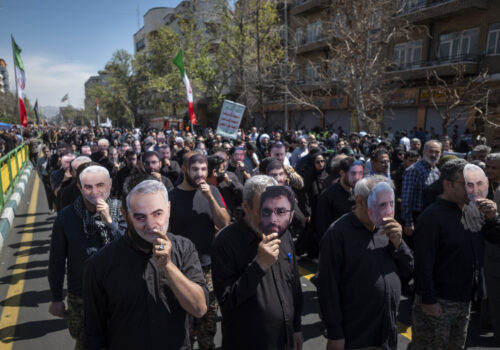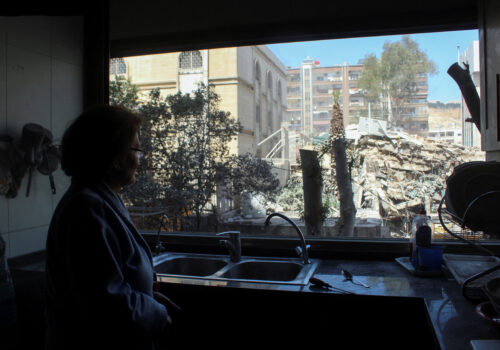Experts react: Iran just unleashed a major attack on Israel. What’s next?
The war is out of the shadows. Using drones and missiles, Iran unleashed a large-scale attack on Israel tonight. The two countries have long been engaged in a “shadow war,” with Iran using its proxies and Israel undertaking targeted assassinations. Most recently, an Israeli strike in Syria killed several top commanders from Iran’s Islamic Revolutionary Guard Corps (IRGC), leading to Iran’s widely anticipated response. What will Israel do next? Has a broader regional war begun? What role will the United States play? Our experts weigh in below.
This post will be updated as the news continues to evolve and more expert responses come in.
Click to jump to an expert analysis:
Jonathan Panikoff: The Middle East is on the precipice of a regional war no one seems to want
Daniel E. Mouton: Israel is leaning on its US insurance policy
Holly Dagres: Iranians react with apparently staged demonstrations—and apprehension
Danny Citrinowicz: Iran’s unprecedented attack may not lead to a regional war
Thomas S. Warrick: The Iranian regime has just made a huge strategic misjudgment
Alex Plitsas: Iranian drones attacked Israel and Ukraine at the same time
R. Clarke Cooper: How Israel’s air defenses work, with US support
The Middle East is on the precipice of a regional war no one seems to want
Iran’s launch of ballistic missiles, in conjunction with over one hundred drones, puts the region on the precipice of a broader war that almost no one seems to actually want; one that most actors—the United States, Arab states, even Hezbollah—have sought to avoid over the last six months.
But the reality is, this is not an expansion of the war in Gaza; it’s a corollary to it. This response by Iran to Israel’s killing of Mohammad Reza Zahedi and six other IRGC officers in Syria almost two weeks ago doesn’t just move the situation up the escalatory ladder—it obliterates the ladder. Iran’s response, supported by Hezbollah, goes far beyond a proportional response.
This marks the first time Iran has launched a direct attack on Israel, and in doing so, it shatters the previous conflict threshold in the long-running war between Israel and Iran, bringing it out of the shadows and into the light.
At best, Israeli Prime Minister Benjamin Netanyahu is almost certain to respond and take steps to attack Iranian targets, probably in Iran, in a manner that will be specific and contained and won’t lead to another significant Iranian response. At worst, the Israeli response will be intense and include the bombardment of important Iranian sites.
The ultimate Israeli response is likely to be determined by the impact on the ground in Israel. Death and destruction of military personnel and especially civilians would massively ratchet up the scale of Israel’s response. As of this writing, what is clear is that this is the beginning of a new era, one in which Iran is willing to respond directly to Israeli attacks and in doing so risk retaliation against the Iranian homeland.
—Jonathan Panikoff is the director of the Atlantic Council’s Scowcroft Middle East Security Initiative. He is a former deputy national intelligence officer for the Near East at the US National Intelligence Council.
Israel is leaning on its US insurance policy
Today’s complex unmanned aerial vehicle (UAV) and missile attack by Iran against Israel is but the next phase of the search for equilibrium and mutual deterrence in the Middle East. The proximate cause of today’s Iranian attack was Israel’s strike against an Iranian diplomatic facility in Syria, which killed several senior IRGC officers. Such an attack made an Iranian response inevitable.
Israel’s early April attack was a result of its continued attempts to reestablish deterrence against Iran following the October 7 Hamas attack. Israel also is aware that it has the temporary advantage of a surge of US military forces in the region. These US forces are Israel’s insurance policy. It is notable that only one year ago, the United States had a fraction of the military aircraft and warships now in the region.
Where things go next will depend on the relative success of today’s Iranian attack. If Iran feels that it has sufficiently responded to the Israeli attack against its facility, then the region will step back from the brink of a wider war. However, if Iran’s attack is overly successful, then Israel will respond. The inevitable response cycle will include the United States and will likely spread across the region.
Regardless of the relative success of the Iranian attack, there are no guarantees that there won’t be another escalatory cycle. Senior officials at the Pentagon have repeatedly made it clear that they want to pull US forces from the Middle East and recommit them to the Indo-Pacific and Europe theaters. Israel knows of this dynamic. Israel feels it must act while it enjoys a strong US force presence. Thus, today’s attack will not be the end.
Other than the continued threat of Iran, the second biggest unresolved issue is lack of transparency. Israeli leaders did not notify the United States of their early April strike on the Iranian diplomatic facility. US forces are deployed to the region as an insurance policy for Israel while it conducts its campaign in Gaza. There is a real need for Israel to share its plans while US leaders must also acknowledge the need to have a serious conversation about maintaining a sufficient presence in the region to aid in the deterrence of Iran.
—Daniel E. Mouton is a nonresident senior fellow at the Scowcroft Middle East Security Initiative of the Atlantic Council’s Middle East Programs. He served on the National Security Council from 2021 to 2023 as the director for defense and political-military policy for the Middle East and North Africa for Coordinator Brett McGurk.
Iranians react with apparently staged demonstrations—and apprehension
Pro-regime Iranians took to the streets in several cities, including the capital, Tehran, to celebrate the Islamic Republic’s response to the April 1 Israeli airstrike on an Iranian embassy compound that killed several high-ranking members of the IRGC. In Tehran’s Palestine Square, pro-regime Iranians happened to be gathered below a new building billboard with a Hebrew shelter sign and writing that reads: “Die from this fear! Is your storage stocked up with enough food and necessities?”—a reference to Iranian retaliation against Israel. Pro-regime Iranians also gathered at the graves of assassinated Quds Force Commander Qasem Soleimani in Kerman and IRGC Quds Force commander for Lebanon and Syria Brigadier General Mohammad Reza Zahedi, whom Israel had just assassinated, in Esfahan. Given that these events happened way past midnight, it appears that these gatherings were pre-planned and state-organized.
While some celebrated the news, other Iranians worried about whether this would lead to a regional war. Footage from social media showed Iranians lining up at gas stations to fill up their cars and, in some instances, hitting up quickie marts to buy food and supplies, given how late at night the events had transpired.
On the official side, posting on X (formerly Twitter), the Permanent Mission of the Islamic Republic of Iran to the United Nations cited Article 51 of the UN Charter to justify its retaliation against Israel but also declared that “the matter can be deemed concluded.” This statement was published before all the drones and missiles had reached their target(s). In essence, the Islamic Republic is suggesting that the events were over before they even started. That may not be up to Tehran.
—Holly Dagres is editor of the Atlantic Council’s IranSource and MENASource blogs, and a nonresident senior fellow with the Middle East Programs. She also curates The Iranist newsletter.
Iran’s unprecedented attack may not lead to a regional war
Following the threats of a leadership that saw the assassination of Mohammad Reza Zahedi in Damascus as crossing a red line, Iran launched an attack on Israel with drones, cruise missiles, and possibly surface-to-air missiles.
Israel and the United States warned Iran not to carry out the attack. Still, it seems that its leadership realized that the price of not attacking is higher than the attack itself, since Iran must restore its deterrence and rebalance the equation of deterrence vis-a-vis Israel.
A lot depends on the attack’s results. Suppose Israel, with the help of the United States, succeeds in intercepting most of the incoming drones and cruise missiles; this will likely allow Israel to respond rationally so that the current conflict between the countries can be “closed.”
In any case, and regardless of the results of the Iranian attack, this is an unprecedented event in the relationship between Iran and Israel. This event highlights the need for Israel to work in coalition with partners against Iran and not rely only on itself in defense, as well as any offensive activities.
If Israel still prioritizes the elimination of Hamas and the release of hostages, any expansion of the current conflict will be counterproductive to these goals. In any case, we are in the preliminary stage of this event, and a lot can change in the upcoming days.
—Danny Citrinowicz is a nonresident fellow with the Atlantic Council’s Middle East Programs and a member of the Atlantic Council’s Iran Strategy Project working group. He previously served for twenty-five years in a variety of command positions units in Israel Defense Intelligence.
The Iranian regime has just made a huge strategic misjudgment
The immediate consequences of the Iranian drone, cruise missile, and ballistic missile attacks against Israel will not be known for several hours, but it looks like the Iranian regime has made a huge strategic misjudgment. Instead of leaving Israelis divided between those who want to defeat Hamas and those who want to see a return of the hostages Hamas kidnapped on October 7, the Iranian regime appears to have made it clear, by overreacting, that Israel needs to go all out to eradicate the threat from Hamas. Otherwise, Israel will face further waves of rocket and missile attacks from next door, not from several hours away.
Iran could have opted for a lesser response to the April 1 strike on a group of IRGC Quds Force leaders who were meeting in Damascus. Regardless of the success or failure of tonight’s attacks from a military perspective, from a political perspective the sheer number of drones and missiles fired—and the fact that they were fired from Iranian territory into Israeli territory—will have more of a lasting impact than the physical consequences that will come into focus in a few hours.
Iran until tonight relied on “plausible deniability” by using proxies to attack Israeli targets in Israel and other countries. That mask is now off. Iranian hopes for Hamas’s survival, which Iran would count as a “victory” no matter how many Israeli and Palestinian civilians died, looks less likely tonight than it did even a day ago. Israeli resolve has been strengthened.
—Thomas S. Warrick is a senior fellow and director of the Future of DHS Project at the Atlantic Council. He served in the Department of State from 1997-2007 and as deputy assistant secretary for counterterrorism policy at the US Department of Homeland Security from 2008 to 2019.
Iranian drones attacked Israel and Ukraine at the same time
Iranian and other officials in the region have confirmed that Iran launched somewhere between fifty and one hundred one-way attack drones as part of this attack. US and allied forces intercepted many of these drones—as well as Iranian missiles—before they reached Israeli airspace. Israel also has one of the best air-defense systems in the world, known as the Iron Dome, which appeared to intercept more.
Iran has been messaging behind closed doors that the regime feels it has to respond to the attack in Damascus, but not to the point that will escalate the conflict. As the situation unfolds in the coming hours and days, the size and the success of the Iranian attack will determine whether or not the situation will continue to spiral or escalate.
Additionally as Saturday turned to Sunday in the region, Russia launched an Iranian Shahed drone attack against Ukraine at the same time Iran launched its own Shahed drone attack against Israel. These drones have become increasingly common, as Russia has used them to attack civilian targets in Ukraine, while Iranian proxy militias in Iraq and Syria have used them to attack US bases as well. These are essentially one-way attack drones that have a payload in the nose cone, and they hit like a rocket. Iran’s attack was just another example of this new phase of warfare.
—Alex Plitsas is a nonresident senior fellow with the Middle East Programs’ N7 Initiative and former chief of sensitive activities for special operations and combating terrorism in the Office of the Secretary of Defense.
How Israel’s air defenses work, with US support
Over the past fifteen years, Israel appropriately upgraded its air defenses in preparation for such attacks as today, adding new systems for interceptions of ballistic missiles fired from as far away as 2,400 kilometers. That interception range includes reaching Iran and where militant proxy groups allied with Iran–such as Yemen, Syria, and Iraq–are based. The Arrow system, designed to intercept ballistic missiles, provides Israel with the top layer of its multi-layered air defense system, together with the well-proven efficacy of David’s Sling and Iron Dome.
The top global recipient of US security assistance, Israel applies much of it to support its sovereign air-defense capabilities. Current US security assistance is guided by a framework that was formalized by a ten-year (2019-2028) Memorandum of Understanding (MOU), but the US commitment to help Israel maintain its qualitative military edge (QME) to counter any credible conventional military threat has been a decades-long policy promise. It was rooted with Israel’s founding and was eventually enshrined into US law.
Then US President Ronald Reagan and then Prime Minister of Israel Yitzhak Shamir announced in 1983 the formation of the Joint Political Military Group (JPMG) for bilateral security cooperation and to support preservation of Israel’s QME to counter threats from any individual state or non-state actors. The bilateral civilian and military JPMG forum continues to play an essential line of communication on requirements as well as an implementation role of the current MOU.
Consistent with the MOU, the United States annually provides $3.3 billion in foreign military financing and $500 million for cooperative programs for missile defense. Since fiscal year (FY) 2009, the United States has provided Israel with $3.4 billion in funding for missile defense. Since FY 2011, for example, the United States has provided $1.3 billion for the Iron Dome system. Further, through FMF, the United States provides Israel with access to some of the most developed military equipment in the world, including the F-35 Lightning fighter jet.
—R. Clarke Cooper is a nonresident senior fellow with the Atlantic Council’s Scowcroft Middle East Security Initiative. He previously served as the assistant secretary for political-military affairs at the US Department of State from 2019 to 2021.
Further reading
Wed, Apr 10, 2024
Four ways Iran could retaliate against Israel’s latest strike
New Atlanticist By Jonathan Panikoff
The question is whether Iran most wants to meaningfully deter Israel or to avoid regional escalation—because Tehran probably cannot do both.
Fri, Apr 5, 2024
Most GCC states condemned the attack on the Iranian embassy complex in Syria. An escalation is what they fear most.
MENASource By Giorgio Cafiero
Fearful that hostilities between Israel and Iran could spiral out of control, the GCC states are keen to avoid the heat as much as possible.
Tue, Apr 9, 2024
Iran talks a big game. But it’s limited in its ability to respond to Israel.
IranSource By Saeid Jafari
There is no doubt that Tehran will respond in some capacity. However, the main issue is that Iran cannot provide an effective and equivalent response.
Image: Iranians celebrate on a street, after the IRGC attack on Israel, in Tehran, Iran, April 14, 2024. Majid Asgaripour/WANA (West Asia News Agency) via REUTERS






